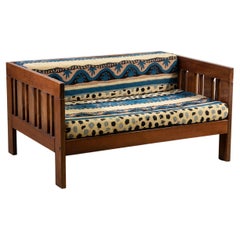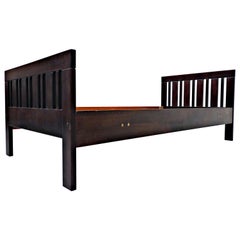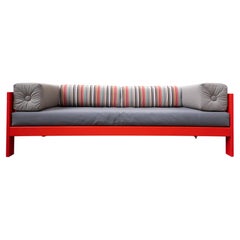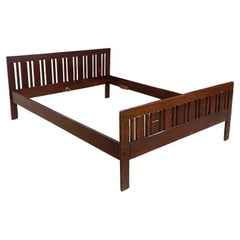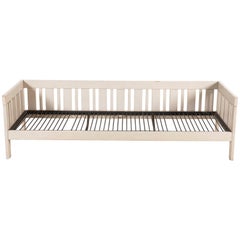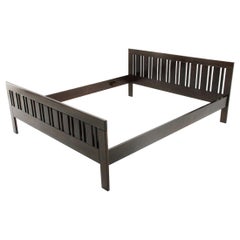Califfo Sottsass
Ettore Sottsass, rare 'Califfo' model armchair, produced by Poltronova, 1965
By Ettore Sottsass
Located in Firenze, IT
RARO ESEMPLARE DI POLTRONA MODELLO CALIFFO
struttura in legno, cuscino e materasso rivestiti in
Category
Vintage 1960s Italian Mid-Century Modern Lounge Chairs
Materials
Steel
$11,340
H 22.45 in W 43.31 in D 31.5 in
"Califfo" Bed by Ettore Sottsass for Poltronova, Mid-Century Modern, 1960s
By Ettore Sottsass
Located in Brussels, BE
"Califfo" bed by Ettore Sottsass for Poltronova, 1960s. Mid-Century Modern
Category
Mid-20th Century Italian Mid-Century Modern Beds and Bed Frames
Materials
Wood
$3,223
H 30.52 in W 37.41 in D 80.12 in
Mid-Century Orange "Califfo" Sofa by Ettore Sottsass, Poltronova, Italy, 1960s
By Ettore Sottsass
Located in Brussels, BE
Mid-Century Modern orange "Califfo" sofa by Ettore Sottsass for Poltronova, Italy, 1960s.
Category
Vintage 1960s Italian Mid-Century Modern Sofas
Materials
Fabric, Wood
$8,191
H 22.05 in W 78.94 in D 31.5 in
Italian mid century solid wood Califfo bed, Ettore Sottsass for Poltronova 1960s
By Ettore Sottsass, Poltronova
Located in MIlano, IT
Italian mid century solid wood Califfo bed, Ettore Sottsass for Poltronova 1960s.
Califfo model bed
Category
Vintage 1960s Italian Mid-Century Modern Beds and Bed Frames
Materials
Hardwood
$4,082
H 31.5 in W 80.32 in D 61.03 in
Recent Sales
Ettore Sottsass White Lacquered 'Califfo' Sofa for Poltronova, 1962
By Ettore Sottsass, Poltronova
Located in Firenze, IT
Very rare and iconic first model of white painted wood Califfo sofa designed by Ettore Sottsass for
Category
Vintage 1960s Italian Mid-Century Modern Sofas
Materials
Steel
'Califfo' Double Bed by Ettore Sottsass for Poltronova, 1960s
By Ettore Sottsass, Poltronova
Located in Savona, IT
Double bed produced in the 1960s by Poltronova based on a project by Ettore Sottsass.
Veneered
Category
Vintage 1960s Italian Mid-Century Modern Beds and Bed Frames
Materials
Wood
Ettore Sottsass, Bed mod. Califfo, Prod. Poltronova, ca 1960
By Ettore Sottsass, Poltronova
Located in Rivoli, IT
Letto modello Califfo con struttura interamente in legno massello a una piazza. Componenti a
Category
Vintage 1960s Italian Mid-Century Modern Beds and Bed Frames
Materials
Wood
20th Century, Ettore Sottsass for Poltronova Daybed mod. Califfo
By Ettore Sottsass, Poltronova
Located in Turin, Turin
Ettore Sottsass grew up in Turin, and graduated in architecture from the Turin Polytechnic in 1939
Category
Vintage 1960s Italian Mid-Century Modern Settees
Materials
Fabric, Wood
Ettore Sottsass Califfo Two-Seater Sofa in Wood and Velvet by Poltronova 1960s
By Ettore Sottsass, Poltronova
Located in Montecatini Terme, IT
contrast with the bright color of the sofa frame.
The Califfo sofa was designed by Ettore Sottsass for
Category
Vintage 1960s Italian Post-Modern Sofas
Materials
Fabric, Wood, Velvet
H 25.6 in W 78.75 in D 31.5 in
'Califfo' 3-Seat Sofa Bed by Ettore Sottsass for Poltronova, 1960s
By Ettore Sottsass, Poltronova
Located in Savona, IT
Sofa bed produced in the 1960s by Poltronova based on a project by Ettore Sottsass.
Structure in
Category
Vintage 1960s Italian Mid-Century Modern Sofas
Materials
Velvet, Wood
People Also Browsed
Pair of Custom Made Sheepskin Karu Armchairs
Located in London, England
A pair of reproduction armchairs in the 1940s Danish modern style.
The Karu chair is a contemporary update of a classic design first produced in Finland by the HAIMI OY company in t...
Category
2010s Swedish Scandinavian Modern Club Chairs
Materials
Sheepskin, Beech, Oak, Walnut
Ettore Sottsass Callimaco Floor Lamp for Artemide
By Artemide, Ettore Sottsass
Located in Glendale, CA
Ettore Sottsass 'Callimaco' floor lamp for Artemide.
Originally created in 1982, Ettore Sottsass’ “horn” of light creates the remarkable illusion of an oversized musical instrument...
Category
21st Century and Contemporary Italian Mid-Century Modern Floor Lamps
Materials
Aluminum
1860s-90s wabi sabi Japanese thick black sliding lattice door w/ panel
Located in 常陸大宮市, JP
New finds from the old-established family house in Ibaraki pref, Kanto area, Japan.
Had been kept with care at the 2nd floor to avoid the humidity , even it was used as the exterior ...
Category
Antique Late 19th Century Japanese Edo Doors and Gates
Materials
Wood
$682 Sale Price
25% Off
H 69.61 in W 33.86 in D 1.26 in
Exquisite Art Glass Bird Bath on Slate Base by Walter Furlan for Murano Glass
By Murano 5
Located in San Diego, CA
Exquisite art glass bird bath on slate base with six removable art glass birds by Walter Furlan for Murano Glass, circa 1960s. This large piece is very difficult to find with six bi...
Category
20th Century Italian Hollywood Regency Decorative Bowls
Materials
Slate
$2,500
H 14.5 in Dm 14.5 in
Restored Art Deco Wardrobe, by J. Halabala, UP Zavody, Mahogany, Czech, 1920s
By Up Závody, Jindřich Halabala
Located in Brandys nad Labem, Středočeský kraj
This elegant Art Deco three-door wardrobe comes from Czechoslovakia from the early 20th century. It is the work of Jindřich Halabala and was custom-made in UP Zavody. The wardrobe is...
Category
Vintage 1920s Czech Art Deco Wardrobes and Armoires
Materials
Wood, Lacquer, Mahogany
$6,816
H 73.23 in W 75.99 in D 23.23 in
Ward Bennett for Brickell Newly Caned "Sled" Lounge Chair, Circa 1970
By Ward Bennett, Brickel Associates
Located in Bainbridge, NY
Original Chromed Steel & Cane Lounge Chair by Ward Bennett for Brickell. Featuring the vintage low chromed x frame, with newly natural and unstained cane seat, curved back, covered a...
Category
Vintage 1960s American Modern Lounge Chairs
Materials
Chrome
$4,500
H 30 in W 27.5 in D 30 in
Tatlin round red velvet sofa by Edra, centre piece, Italy, 1980s
By Edra
Located in Zevenaar, NL
This red velvet Tatlin sofa was designed by Mario Cananzi and Roberto Semprini for Edra in the 1980s. Inspired by the famous Tatlin tower, a symbol of constructivism created by Vladi...
Category
21st Century and Contemporary Italian Futurist Sofas
Materials
Steel
$5,403 Sale Price
40% Off
H 82.68 in W 68.9 in D 53.15 in
Rare Arne Norell Ilona Sofa in Original Green Leather, Sweden, 1970s
By Arne Norell, Norell Möbel AB
Located in Lewes, East Sussex
An original two-seat Arne Norell Ilona sofa in original patinated green leather. Made by Norell Mobler in Sweden. In very good vintage condition with minor signs of use and wear rela...
Category
Mid-20th Century Swedish Mid-Century Modern Loveseats
Materials
Brass
$6,860
H 31.5 in W 63 in D 30.71 in
Japanese Antique Drawer Storage 1880s-1900s Shelf Chest Drawers Wabi-Sabi
Located in Chiba, Chiba
This is an old Japanese drawer storage shelf.
This was made during the Meiji period.
All the shelves are made from solid chestnut wood.
After more than 100 years, it has become more ...
Category
Antique Late 19th Century Japanese Meiji Furniture
Materials
Wood
$950 Sale Price
20% Off
H 16.93 in W 28.82 in D 10.91 in
Early Eames Time Life Lobby Desk Chair Reupholstered in Forest Green Leather
By Charles and Ray Eames
Located in Seattle, WA
The Eames time life "lobby" chair was designed in 1960 for the reception areas of the Time-Life building in New York by Charles & Ray Eames. The time life lobby chair combines the ch...
Category
Vintage 1980s North American Mid-Century Modern Swivel Chairs
Materials
Aluminum
$4,495
H 31 in W 29 in D 28 in
Round Post Modern 1980s Brutalist Mcm Beech Dining Chairs, Set of 6
By Afra & Tobia Scarpa
Located in Basel, BS
Absolutely incredible, and very stylish Post Modern Brutalist set of 6 dining chairs.
Extreme attention to detail on these masterfully made chairs and table--Sculptural elements thr...
Category
Vintage 1980s Italian Brutalist Dining Room Chairs
Materials
Beech
$8,562 Sale Price / set
20% Off
H 27.25 in W 22.75 in D 21.75 in
Italian Art Deco 1940s Wardrobe
Located in Milan, IT
Splendid Italian 1940s Art Deco wardrobe.
Category
Vintage 1940s Italian Art Deco Wardrobes and Armoires
Materials
Wood
Italian 1970's Cocktail Dry Bar in Joe Colombo Style, Italy - circa 1975
By Joe Colombo
Located in Pijnacker, Zuid-Holland
Vintage 1970s Italian Mobile Dry Bar / Cocktail Bar – Mid-Century Modern Elegance
The colour of the dark lacquered wood is an amazing very dark purple / aubergine (almost black).
Th...
Category
Vintage 1970s Italian Mid-Century Modern Dry Bars
Materials
Chrome
$10,643
H 89.77 in W 60.63 in D 43.31 in
Red Steel "Bambù" Double Bed by Giovanni Ausenda for Ny Form, Italy, 1970s
By Giovanni Ausenda, Ny Form
Located in Milan, IT
Minimal "Bambù" double bed by Giovanni Ausenda for Ny Form.
Red steel frame and brass details.
Wood slates frame available.
Literature: Casa Vogue Magazine #53/45 February 1976
Category
Vintage 1970s Italian Beds and Bed Frames
Materials
Brass, Steel
$3,432
H 24.41 in W 74.81 in D 83.47 in
1980s Italian Lucite and Brass Bar Cart with Glass Shelves, on Castors
By Pierre Vandel, Charles Hollis Jones
Located in Glasgow, GB
A striking vintage Italian bar cart from the 1980s, this piece captures the essence of Hollywood Regency style with its sculptural profile and interplay of luminous materials.
The f...
Category
Vintage 1980s Italian Hollywood Regency Carts and Bar Carts
Materials
Brass
On Hold
$1,166
H 31.5 in W 16.54 in D 11.03 in
1970s Space Age Steel and Glass Bar Cart by Claudio Salocchi for Luigi Sormani
By Luigi Sormani, Claudio Salocchi
Located in Aci Castello, IT
1970s Claudio Salocchi for Luigi Sormani Space Age Bar Cart in Brushed Steel and Smoked Glass.
A stunning embodiment of Italian Space Age design, this rare bar cart by Claudio Salocc...
Category
Mid-20th Century Italian Space Age Carts and Bar Carts
Materials
Stainless Steel
$4,185
H 29.14 in W 24.81 in D 29.14 in
Get Updated with New Arrivals
Save "Califfo Sottsass", and we’ll notify you when there are new listings in this category.
